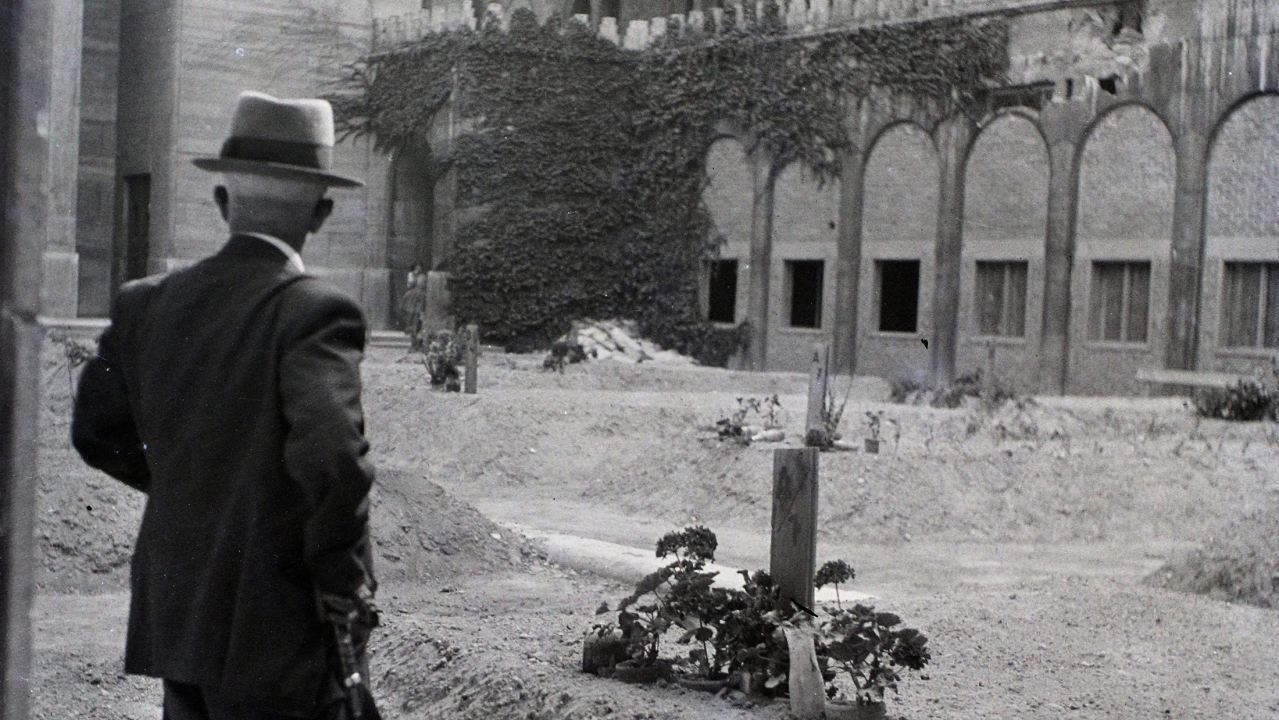The deportations of Hungarian Jews, which occurred late in the war, but were no less extensive and deadly, reveal a strange paradigm of Hungarian-Jewish relations. To many observers, it appears as if Hungary, which had prevented the deportation of her Jews for most of the war, had suddenly changed her mind and cast them out. This tragic story, while both appalling and unjust, also shows the role of misfortunate and chance in world history. Had the war gone another manner of way, such as an Allied landing in the Balkans in 1943, almost 500 000 Hungarian Jews would have been saved from the holocaust. Today, Hungary would be known as a country where not only Hungarian Jews found refuge, but would be a safe haven for Jews throughout the war.
This historical episode raises numerous questions, one of which being the nature of the chronological events leading up to the extermination of the Hungarian Jews. Should historians consider the antisemitic laws initiated by the Hungarian Parliament, partly under the German pressure, between 1938 and 1943, potentially including earlier laws passed in 1920, as a series of steps which inescapably ended up in extermination in 1944? It is on this question that opinions diverge, with many debates ultimately leading to the question of the uniqueness of the Holocaust. Regardless of one’s opinion, it is clear that time as a factor, in both a chronological and duration sense, highlights the difficulty in understanding the historical phenomenon of the persecution of Jews in the 20th century.
‘Understanding’ – this is the last word of the book written by László Bernát Veszprémy. Understanding, according to Veszprémy, is not about providing excuses, explanations, nor indictments of historical actors, process, and events, instead it is simply the mission of the historian. In other words, it is about telling the story without getting lost in hindsight. It is admitting that those who lived through historical tribulations had neither a clear possession of a clear vision of the facts, nor an exact knowledge of the consequences of their actions.
Veszprémy has chosen to approach his subject through the study of the controversial Jewish Councils (Judenräte), of which the Germans established approximately 150 throughout Hungary. These councils faced two major dilemmas: how far should they go in compromising themselves and with what aims? (and to what extent does this dilemma reflect the similar question faced by Hungary?) The book structure is both chronologic and thematic. It separates, on one hand, three periods, marked by the German invasion (19th March 1944) and the accession to power of the Arrow Cross fascist party (15th October); and on the other hand, the countryside and Budapest. The latter distinction is important because the majority of the Budapest’s Jewish community survived, while most of the Jews outside the capital died in Auschwitz, but also from the historiographical point of view. After the war, survivors from the countryside often accused the Central Jewish Council (or Budapest Jewish Council) of abandoning them. This is why, in his last chapter, the author briefly explores historical works and polemics in the post-war decades.
The book itself is very well documented and relies on a vast bibliography as well as several archives in Hungary, the United States, Germany, and in Israel. All this provides a good summary or synthesis of both unknown and well-known facts. Using these sources, the book depicts each important period in the persecution and extermination of Hungary’s Jews. Beginning with April to July 1944, when a massive deportation occurred of most Jews living in the provinces and part of those living in the suburbs of Budapest. Veszprémy’s narrative continues through July to October, including the initial interruption of the deportations, and ending with the period from October 1944 to January 1945, which includes the ghettoization of Budapest Jews, worsening persecution and robberies carried out by criminal gangs led by the Arrow Cross government, and finally, the liberation of the city and of the ghetto by Soviet troops.
Approaching those events through the lens of the Jewish Councils allows the reader to observe the complexity of the Jewish community, ranging from the Orthodox to neológ or Conservatives, to even the Christian converts (who were granted their own council in Budapest). In addition to this complex system, were the Zionists, with their own right and left-wing divisions. This complexity and fragmentation caused tensions and rivalries within the Jewish community. Another interesting facet of Veszprémy’s analysis is understanding the councils as institutions with all the tasks, problems, and structures of any bureaucracy. Under the councils’ supervision were several commissions, dedicated to supply, health, etc. A so-called housing commission, which functioned as an expropriation commission, had almost a thousand employees in Budapest, not to mention the ‘Jewish police’ in charge of maintaining order in the ghettos. While the Council was trying to handle everyday matters, such as food rationing, the institutional apathy of the councils prevented a correct awareness of their increasingly dire situation, particularly in the countryside. Nevertheless, it was not truly possible to overlook these concerns.
As far as the different members of the councils are concerned, Veszprémy underlines the loyalist attitude of the neológs and Orthodox Jews, who called “the Almighty’s benediction” upon the Regent of the country, [Miklós] Horthy, and, as late as 1943, were praising the government for its favourable treatment of Jews, contrasting its attitude to what was happening in neighbouring countries (pages 17, 19). The Zionists, however, were more inclined toward clandestine activities, such as the manufacturing and distribution of illegal documents, or even occasional physical resistance. This being said, the president of the Budapest Jewish Council, the neológ Samu Stern, was the one who supported the most ambitious rescue operation, with which the author draws interesting parallels between the action of the central Jewish Council and of the regent Horthy. Veszprémy comments: “the debate has gone so awry – and has been so much mixed up with memory politics focusing on the role of Horthy – that it has absolutely left aside the role played by the Central Jewish Council in the matter.” (157)
Here he speaks of the ‘Koszorús action’, named after the Hungarian army general who, in the beginning of July 1944, ordered his armoured vehicles to move into Budapest and remove the gendarmerie. The gendarmerie had previously been placed in Budapest to help with the planned deportation of its Jews. This operation appears to have emerged from contacts between the Jewish Council and the Regent himself. Veszprémy demonstrates that, after the war, nobody highlighted the Jewish Council’s contribution, instead most Conservatives, in exile, preferred to praise the Hungarian army officer. The communists, on the other hand, would dispute the very existence of the whole affair. Veszprémy utilizes postwar confessions and testimonies from the ‘People’s Tribunals’. The author notes that while dates are sometimes mixed up in these testimonies, one should keep in mind the real possibility of bad memory, and that one should know how to read between the lines.
As far as the Regent is concerned, Veszprémy underlines his apparently uncertain intentions. At the time of the Koszorús action, there was a rumour that the gendarmerie were preparing a coup d’état against Horthy. Thus the question remains: which of the two factors guided the Regent into ordering the removal of the gendarmerie from Budapest? Was it the rescue of the Jews, or was it the prevention of a putsch, or perhaps a combination of the two? As an answer, Veszprémy cites a diary entry from a confidant of Horthy which revealed the Regent wanted to rescue the Jews of the city, while also avoiding a coup. Veszprémy also adds that the myth of a takeover could have been disseminated to deceive the Germans. He then concludes his argument by mentioning another rescue operation, which was never put into practice. This operation would have moved Budapest Jews in a camp not far from the capital, to prevent their deportation and avoid the fate of their their rural co-religionists. This plan was never executed, however, as it presented too high a risk.
That being said, as with the Koszorús action, Veszprémy suggests a nuanced analysis is necessary to shed a light on Horthy’s mentality. “The fact that the Regent’s acting would finally have deceived the historians should not surprise us. In his own memoirs, he hardly mentions these events, writing only a few lines on the Koszorús action, then simply saying he did not agree with the deportation of Budapest Jews. Perhaps he was ashamed that his name should be associated with a plan, involving concentrating the Budapest Jews. […] Another possibility is that due to his antisemitism, he was ashamed of having intensive contacts with the Jewish leaders.” (171)
Another pursuit of Veszprémy, through his research is the connecting actions and opinions with information, persuing the importing question of who knew what, and since when? Here again, dates and testimonies are intertwined. In Horthy’s memoirs, he says that he learned of Auschwitz in August 1944. Veszprémy writes: “This is obviously a deliberate changing of facts”. (156) Nevertheless, the author points out that it was not only about knowing the facts, but also of “internalizing” them, a problem, the author notes, faced the everyone, not just the Regent, but also the Jews themselves, in particular those who were members of the Councils.
Veszprémy reports that information on the Jewish deportations were available in the Hungarian press, gleefully reported by the antisemitic press, but also in the general and even Jewish press. Auschwitz, in particular, was also known due to the Jews who served with the unarmed labour battalions of the Hungarian army on the Eastern front. Despite the deplorable and often fatal conditions of life there, the unarmed labour service was a way out of deportations. Often, Veszprémy relates, the knowledge of death camps did not modify the behaviour of those most concerned. As an example, a doctor from Munkács later recounted that he knew everything about Auschwitz, but nevertheless embarked on a train heading to Auschwitz with his daughter, who was eventually gassed. In the eyes of the Hungarian Jews, Hungary was a different country, where things would be different, and they almost were, as was mentioned earlier. “The problem was not that anyone had kept the news about the Holocaust away from the Jews, but that most of them didn’t understand, perhaps didn’t want to understand, what they could very much hear. Hungarian Jewish leaders were aware of the Holocaust, but they thought it could not and would not happen to them.” (39) Knowing – really knowing – in one way amounts to giving away all hopes. Therefore, one would rather refuse to know. Finally, we can draw from Veszprémy’s analysis a list of several factors which could (tenuously) sustain hope: genuine or forced disbelief, loyalty to the homeland, lack of real alternative, fatalism or plain fatigue. All the same, hope was not entirely irrational, or unjustified, since the majority of Budapest Jews, though severely abused until mid-January 1945, survived.
A contrario, it brings us back to the fate of countryside Jews. After the war, the Budapest Jewish Council was often criticized for its inaction toward the deportations perpetrated in the countryside. Veszprémy draws a more nuanced picture of the matter and provides, for instance, details on the logistic and financial support the Budapest Council sent to those outside the capital. He also highlights the difficulties and risks which a more radical action could have induced. Regardless, Samu Stern, the president of the Budapest Jewish Council, only escaped postwar persecution due to his death in 1946. Other Jewish leaders were not so lucky, due to the sovietisation of Hungarian society, the new communist regime would target the Hungary’s old elite, to which the very members of the Jewish Councils often belonged.
In his book, Veszprémy concentrates his research on two interesting figures, a member of the Budapest Council and rabbi, Béla Berend, and on a convert, Sándor Török. These two cases allow him to illustrate several key problems facing the Jewish community (beyond that, the paths of the two men are skilfully brought together by means of a letter of Carl Jung on the question of exile). After the war, Berend was sentenced to thirteen years in prison as a result of a People’s Tribunal, which Veszprémy describes as a political trial. Berend, however, was acquitted after an appeal in 1947 and went into exile to the United States. Incidentally, Berend is also linked to the question of mass Jewish conversions to Christianity, which the rabbi had publicly scourged, as well as Zionist emigration. Similar to the more famous Rezső/Rudoph Kastner, Berend attempted to buy the life of Hungarian Jews by promising their eventual emigration to Palestine. Berend even claimed to have been the mastermind behind the aborted plan of a ‘false’ concentration camp for Budapest Jews, though, as Veszprémy underlines, “he appears to have remembered this only in the 1980s.” (171)
Through the life path of Berend, historiography and history meet in a vertiginous ballet, which Veszprémy sets to music in a spectacular manner. In the United States, while changing his domicile, his work, and even his name, Berend went to battle with his adversaries, particularly with Randolph L. Braham, an American historian who dedicated his career to the pursuit of Nazi criminals. Braham who gave special attention to Hungary, according to Veszprémy, was not always using the best scientific practices. Moreover, Veszprémy implicitly draws an analogy between the specific antagonism between the two men and the conflict within the Jewish community between ‘patriots’ and ‘liberals’, which itself reflected the polarisation of Hungarian society.
Testifying as an expert during the trial of a former member of the gendarmerie, in 1990, Randolph L. Braham testified that his “function is to pursue the truth”, adding “I try to comprehend the incomprehensible.” Similar to the words of Veszprémy, the two historians’ respective narrations of the life of Béla Berend, however, imply two totally different, even incompatible understandings.
According to Braham, if Berend was guilty, then the Jewish Council was guilty, then the Hungarian elite was guilty, then, in particular, was the regent Horthy as leader of the whole hierarchical society guilty. Braham viewed both Hungary and its past as guilty, believing it was necessary for the society to break absolutely with the past order which allowed the holocaust to occur. Once this was done, the world could go forward, toward a world which shall be new and liberal.
Veszprémy argues that Berend was attacked because he was a member of the Jewish Council. Attacking him meant attacking the elite, serving as a similar scapegoat as the regent Horthy. Horthy has often been attacked without nuance, in order to condemn, in fine, the past and the nation. Veszprémy advocates for a more balanced view on history, searching for important values which can reinforce the nation. In his view, the responsibility for the Holocaust is not in the past itself, but that it was a disorder from which the future needs to be spared from.
-
Veszprémy László Bernát: Tanácstalaság. A zsidó vezetés Magyarországon és a holokauszt, 1944-1945. Jaffa Kiadó, 2023, 319 pages
Photo: Fortepan 116650









